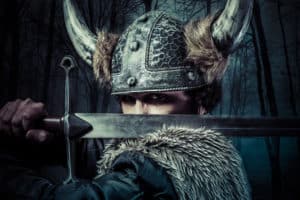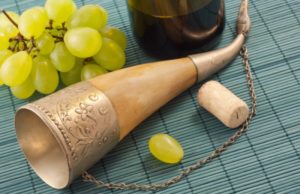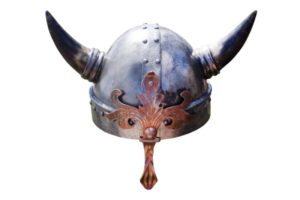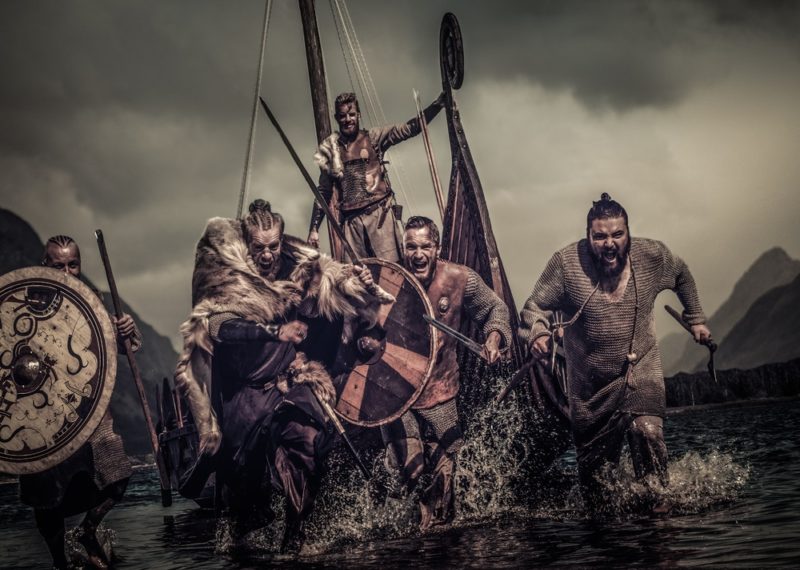If you’ve ever seen a Viking costume, television show, or movie, you’ve noticed Viking horns before. They’re quite popular, and the helmets give the wearer a certain feeling of power. However, the question is whether or not the Vikings actually wore horned helmets, and the answer to that is no.
While the Scandinavians likely sported headgear as they marched into battle, there’s no proof to indicate that they were festooned with horns.
Overall, depictions that date from the Viking age (anywhere between the 8th and 11th centuries) show warriors bare-headed or wearing simple helmets made of leather or iron.
In fact, archaeologists have searched high and low, never uncovering a Viking-era helmet with horns. There’s only been one full helmet that’s turned up that had to be Viking. It was discovered in Norway on the Gjermundbu farm in 1943. It’s a 10th-century artifact with a rounded iron cap, a guard for the nose and eyes, and no horns at all!

Who Created Horned Helmets?
The popular image you see of Vikings with horned helmets goes back to the 1800s. Scandinavian artists included that headgear to portray the raiders. Sweden’s Gustav Malmstrom was one of them. Also, Wagner had a large opera cycle back in the 1870s, and the costume designer chose horned helmets for the Vikings to wear, causing the stereotype to be born.
Doepler, Malmstrom, and others were likely inspired by the 19th-century discovery of horned helmets, but they predated the Vikings. They could also have looked to Roman and ancient Greek chroniclers, who often depicted northern Europeans as wearing helmets that were adorned with ornaments, such as antlers, wings, and horns. Still, the headgear fell out of fashion about a century before the Vikings ever showed up, so it was probably donned only for ceremonial purposes by Germanic and Norse priests.
Overall, horns are very practical in combat and are almost dubious. While the horn might intimidate enemies or poke out some eyes, each horn was more likely to get embedded in a shield or entangled in tree branches.
Helmets Worn in the Viking Age
Archaeologists have uncovered parts of helmets in Denmark and Asia. They include brow ridges that protect the warrior’s face. Few helmets were likely found (with or without the horn addition) because the Vikings rarely put them in the graves with the people. Plus, helmets weren’t sacrificed like swords and spears.
Another likely theory is that most Vikings preferred not to wear a helmet. Depictions of warriors without headgear aren’t popular, though. Therefore, it’s more fun to use your imagination and think of a unique helmet with horn decorations all over it. Still, the evidence points to them being made of leather or iron and being few and far between.

The Drinking Horn
While the helmet horn might have been shot down, there is still the question of the drinking horn. There’s evidence showing that Vikings did use drinking horns, especially for special events. However, the world has changed the usage for them, so they aren’t as practical now. Regardless, they are often used in ceremonies and rituals to this day. You can find a drinking horn with a stand, making you feel like the warriors must have after a battle in Norway.
FAQs
Weren’t There Pictures of Horned Helmets on Tapestries?
Depictions in the Iron age do show people with horned heads or helmets, like the Golden Horns. Some images are from the Viking period.
For example, the Oseberg burial in Norway dates back to the early Vikings period, and a tapestry was found with horned helmets depicted. However, that doesn’t prove all Vikings wore them. Still, there’s evidence suggesting that some warriors wore the headgear, and the horned figures are berserkers. These were wild men who preferred to throw themselves into battle in an almost trance-like state.
Overall, the berserkers were the most feared Vikings of all time. They turned a love of war into life without family and friends.
With that, horned headgear could have been worn for cultic and display purposes. It’s not to say that they didn’t have them or wear them, but the chances of them going to war while wearing them are slim. They could get in the way, and it was likely seen as a waste of resources on someone likely to get killed.
Why Do Television Shows and Movies Show Them With Horned Helmets?
Most television and movie producers deliver what popular culture tells them to show. The horned helmet looks cool, it films well, and people like to see them.
Were Drinking Horns Real?
Yes, drinking horns were real in the Viking age, but they also used blowing horns to announce their victories and warn others of danger. You may find these items for sale online. While they may be high-quality, they are replicas of what the Vikings probably had in the past. There’s still little proof of what they looked like, and they were probably made of different materials back then than now.
Conclusion
While having horns on helmets can be fun when you’re watching a movie, it’s unlikely that the Vikings wore them during times of war. However, there is some proof to show that they wore headgear, and a few tapestries indicate that the horn was used to adorn them.
Overall, though, these men and women probably used the horn to hold beverages and to help sound an alarm for danger.



